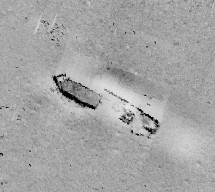Mystery in the mesophotic
Our goal for this project was to document three shipwrecks and associated hard-bottom sites - that was the bar for success. By the end of the day on the Hamlet, we had reached that bar, and we still had an extra day at sea. We transited a few miles back toward land and set about investigating a new shipwreck.
 |
| Sonar image of the unknown wreck |
Tubastraea coccinea is not native to the Gulf of Mexico. It comes from the Indo-Pacific and has spread across much of the Gulf and Caribbean since its arrival. It loves to live on the underside of overhangs, hanging upside-down. Those types of structures are usually rare on natural hard-bottom reefs (or if there are overhangs, they're just on the bottom side of a rock and therefore pretty close to the ground). Shipwrecks, on the other hand, provide plenty of overhangs - the underside of the stern, any piece that sticks out, and pretty much anywhere if the wreck ended up on its side. I can see why Tubastraea loves shipwrecks.
The next thing we noticed were fishing nets - tons of them. A giant one stretched along the starboard side of the wreck, covering up much of the hull. The material on all the nets was uniform, suggesting they had come from a single source, probably the ship itself. The mesh size was pretty big - too big for shrimp - so this vessel may have been catching fish. We scanned along the starboard side and found net after net.
Back toward the bow, we noticed a tall structure with a window in it. Evan got on the radio and asked if the ROV could peek in the window - he just couldn't resist. The pilot carefully maneuvered into the opening as Evan adjusted the focal length on the camera. Slowly, a structure came into focus, as if emerging from a cloud of mist: the ship's wheel. It was an old-school style wheel - a giant wooden circle with rounded spokes sticking out. Tubastraea clumps rested on some of the spokes. Calvin, ever the poet, started narrating: we were looking at the spot where the captain of this vessel took his last stand to save his ship from the sea. Our eyes were the first to view this wheel since that fateful day. The team fell silent for a moment.
Eventually, we noticed that the ROV was stirring up a lot of sediment as it maneuvered around the wreck, and our visibility was declining. We decided to quit while we were ahead and recover the ROV.
It has been a highly successful cruise in the Gulf of Mexico. We collected valuable, informative, and novel data from four shipwrecks and three hard-bottom sites. I am going home with a hard drive full of video, and I am very grateful for that.
Comments
Post a Comment